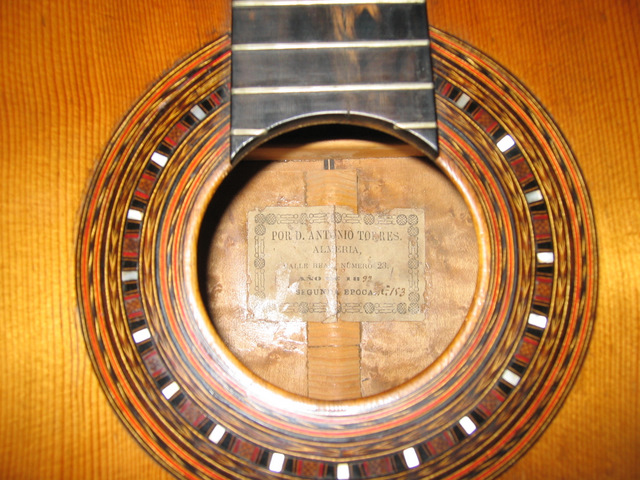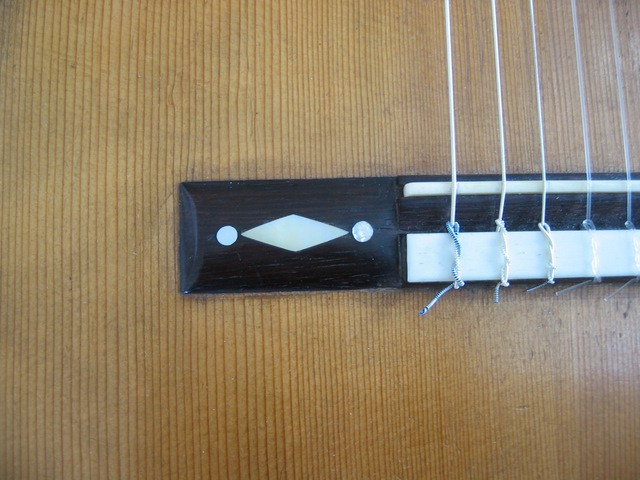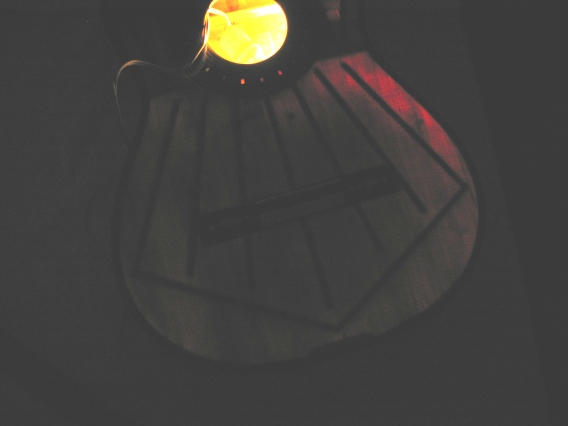 The original is from 1892 and is number SE 153 as you can see from the label. I saw the original for the first time at a concert and workshop given by the owner Carles Trepat here in Spain. We talked and I looked at and listened carefully to the guitar privately. The idea to make a replica matured over the next year and we arranged to meet to take measurements and photos. In the end I had to travel from Granada to Lerida (near Barcelona) to meet with Carles because although he had been in this area he was busy with concerts and masterclasses. I convinced my master Rolf Eichinger to make the trip with me because I felt I needed his vast knowledge of historical instruments and how to read backwards from what you see on a 100 plus year old guitar. So many things can change like arching, neck angle and even thicknesses over time. We spent almost an entire day with the instrument and I took careful notes and these and other pictures. We reconstructed the original arching of the guitar taking into account the angle of the top where it meets the sides at different points and disregarding the actual arching present today. We took thickness measurements and tried to account for the final sanding and tried to spot repairs and refinishing. The typical situation of slightly thinner perimeter usually indicates the above and not a desire by the maker to leave that part thinner.
The original is from 1892 and is number SE 153 as you can see from the label. I saw the original for the first time at a concert and workshop given by the owner Carles Trepat here in Spain. We talked and I looked at and listened carefully to the guitar privately. The idea to make a replica matured over the next year and we arranged to meet to take measurements and photos. In the end I had to travel from Granada to Lerida (near Barcelona) to meet with Carles because although he had been in this area he was busy with concerts and masterclasses. I convinced my master Rolf Eichinger to make the trip with me because I felt I needed his vast knowledge of historical instruments and how to read backwards from what you see on a 100 plus year old guitar. So many things can change like arching, neck angle and even thicknesses over time. We spent almost an entire day with the instrument and I took careful notes and these and other pictures. We reconstructed the original arching of the guitar taking into account the angle of the top where it meets the sides at different points and disregarding the actual arching present today. We took thickness measurements and tried to account for the final sanding and tried to spot repairs and refinishing. The typical situation of slightly thinner perimeter usually indicates the above and not a desire by the maker to leave that part thinner.  Rolf was always obsessed with the harmony and aesthetics of the body shapes of the great makers’ guitars and his extensive experience in reconstructing those curves with compas and rule allowed me to make an accurate mold which made for a symmetrical and blanced body form; original but without the typical variations which are usually present in historical instruments.
Rolf was always obsessed with the harmony and aesthetics of the body shapes of the great makers’ guitars and his extensive experience in reconstructing those curves with compas and rule allowed me to make an accurate mold which made for a symmetrical and blanced body form; original but without the typical variations which are usually present in historical instruments.
My intention with this guitar is to make a perfect copy and at the same time to get as close to the sound of the original as possible. I think to do both is impossible because of the time that has passed since 1892. In order to get closer to the sound of the original I work slightly thinner and try to use my oldest and lightest-weight wood.  I even try to use similar looking top wood. My philosophy of the copy is that the aesthetics and measurements should be the same but when it comes to techniques and methods which are not evident in the guitar I don’t trust what the “experts” claim were the methods of Torres. Rather I think that the closest we can come to his methods is to follow the tradition he helped establish and to use those techniques still alive today.
I even try to use similar looking top wood. My philosophy of the copy is that the aesthetics and measurements should be the same but when it comes to techniques and methods which are not evident in the guitar I don’t trust what the “experts” claim were the methods of Torres. Rather I think that the closest we can come to his methods is to follow the tradition he helped establish and to use those techniques still alive today.
Anything I have modified has been to make the guitar a better tool for the musician. Things like: some of the frets were not perfectly placed and the bridge compensation was not right on the original, since my guitar is thought to be very comfortable I carve the neck to a similar shape on this model, I make a small lip on the back of the bridge as added insurance against the bridge lifting. The weight of the original was 1225g and the weight of my first copy (maple) was 1232. That was just chance but it was satisfying. I don’t worry about a specific weight or body frequence the way some makers do but I do try to keep the guitar light. This guitar has taught me so much, I find myself needing to invent methods to achieve certain effects (on the rosette for example) and then I realize that Torres MUST have done it the same way so I have invented nothing.
I am sure you are familiar with the technique of placing a light bulb inside the guitar to see the fan bracing. However, with very old guitars the top is not nearly so translucent so I had to doctor this shot a bit to get the fans to show up clearly. They were perfectly visible for the purpose of making my drawing but the original photo was not suitable for posting.
Here is a video of Trepat playing the original.
